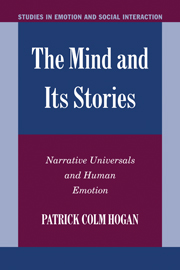Book contents
- Frontmatter
- Contents
- Acknowledgments
- The Mind and Its Stories
- Introduction: Studying Narrative, Studying Emotion
- 1 Literary Universals
- 2 Emotion and Suggestion: Lexical Processes in Literary Experience
- 3 Four Hypotheses on Emotion and Narrative
- 4 Writing Beyond the Ending: A Problem of Narrative, Empathy, and Ethics
- 5 Extending the Theory: Emotion Prototypes, Narrative Junctures, and Lyric Poetry
- 6 Testing, Revision, and the Program of Research in Narrative Universals: Ainu Epic and the Plot of Sacrifice
- 7 The Structure of Stories: Some General Principles of Plot
- Afterword: From the Emotional Nature of Narrative to the Narrative Nature of Emotion
- Works Cited
- Index
- Titles in the series
Introduction: Studying Narrative, Studying Emotion
Published online by Cambridge University Press: 11 July 2009
- Frontmatter
- Contents
- Acknowledgments
- The Mind and Its Stories
- Introduction: Studying Narrative, Studying Emotion
- 1 Literary Universals
- 2 Emotion and Suggestion: Lexical Processes in Literary Experience
- 3 Four Hypotheses on Emotion and Narrative
- 4 Writing Beyond the Ending: A Problem of Narrative, Empathy, and Ethics
- 5 Extending the Theory: Emotion Prototypes, Narrative Junctures, and Lyric Poetry
- 6 Testing, Revision, and the Program of Research in Narrative Universals: Ainu Epic and the Plot of Sacrifice
- 7 The Structure of Stories: Some General Principles of Plot
- Afterword: From the Emotional Nature of Narrative to the Narrative Nature of Emotion
- Works Cited
- Index
- Titles in the series
Summary
When empirical researchers in the social sciences consider the nature of emotions and emotion concepts, they most often conduct anthropological interviews, send out surveys, analyze linguistic idioms, test stimulus response times, and so on. They may move toward medical and biological study as well, giving injections to test subjects, engaging in neuroimaging, and the like in order to gather as much relevant data as possible. But, with only a few exceptions, they almost entirely ignore a vast body of existing data that bears directly on feelings and ideas about feelings – literature, especially literary narrative. Stories in every culture both depict and inspire emotion. Indeed, the fact that some stories are highly esteemed in any given culture suggests that those stories are particularly effective at both tasks – representing the causes and effects of emotion as understood or imagined in that society and giving rise to related emotions in readers. Of course, one cannot assume that depictions of emotion accurately represent those emotions. This is the common, and quite reasonable, objection to treating literature as empirical data. However, we have very good reason to assume that widely admired depictions of emotions tell us something important about the way people in a given society think about emotions. In other words, we have a body of commonly enjoyed, elaborate, narrative portrayals of emotion scenarios. At the very least, these would seem to tell us far more about common emotion ideas than some verbal definition of an emotion term.
- Type
- Chapter
- Information
- The Mind and its StoriesNarrative Universals and Human Emotion, pp. 1 - 16Publisher: Cambridge University PressPrint publication year: 2003



